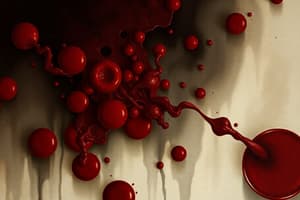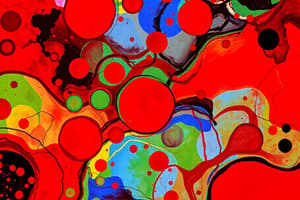Podcast
Questions and Answers
What is the primary role of eosinophils in the immune system?
What is the primary role of eosinophils in the immune system?
- To defend against allergic reactions and parasitic infections (correct)
- To produce circulating antibodies
- To promote blood clotting
- To facilitate the activation of T-lymphocytes
Which type of white blood cell is responsible for producing circulating antibodies?
Which type of white blood cell is responsible for producing circulating antibodies?
- B-lymphocytes (correct)
- Basophils
- Eosinophils
- Monocytes
What triggers monocytes to differentiate into macrophages?
What triggers monocytes to differentiate into macrophages?
- Encountering harmful substances (correct)
- Activation by lymphocytes
- The presence of platelets
- Injury to blood vessels
What is the lifespan of platelets in the bloodstream?
What is the lifespan of platelets in the bloodstream?
What is the main site of hematopoiesis in adult humans?
What is the main site of hematopoiesis in adult humans?
What is the primary function of red blood cells (RBCs)?
What is the primary function of red blood cells (RBCs)?
What condition is characterized by a decrease in white blood cells?
What condition is characterized by a decrease in white blood cells?
What component of blood is primarily responsible for its red color?
What component of blood is primarily responsible for its red color?
Which type of white blood cells are most abundant in the human body?
Which type of white blood cells are most abundant in the human body?
What type of granules do granulocytes possess?
What type of granules do granulocytes possess?
Flashcards
Plasma
Plasma
The fluid component of blood that makes up 55% of its volume, primarily composed of water and containing dissolved nutrients, proteins, gases, and waste products.
Red Blood Cells
Red Blood Cells
The red blood cells (RBCs) responsible for carrying oxygen from the lungs to the tissues and carbon dioxide back to the lungs.
Blood Clotting
Blood Clotting
The process of forming blood clots to stop bleeding by converting fibrinogen into fibrin.
Granulocytes
Granulocytes
Signup and view all the flashcards
Neutrophils
Neutrophils
Signup and view all the flashcards
Eosinophil
Eosinophil
Signup and view all the flashcards
Basophil
Basophil
Signup and view all the flashcards
Lymphocyte
Lymphocyte
Signup and view all the flashcards
Monocyte
Monocyte
Signup and view all the flashcards
Platelet
Platelet
Signup and view all the flashcards
Study Notes
Blood Composition and Function
- Blood is a liquid connective tissue circulating in the cardiovascular system (CVS).
- Total blood volume is approximately 6 liters.
- Blood is composed of plasma (55%) and formed elements (45%).
- Plasma is the liquid component, containing water, proteins, nutrients, and waste products.
- Formed elements include red blood cells (RBCs), white blood cells (WBCs), and platelets.
- RBCs (erythrocytes) make up 45% of blood and transport oxygen and carbon dioxide.
- RBC lifespan is 100-120 days.
- RBC production increases at high altitudes or when oxygen levels are low (anemia), and decreases when there are sufficient levels of oxygen.
- Hemoglobin is a protein in RBCs which binds to and transports oxygen.
- WBCs (leukocytes) defend the body against infection and disease.
- Platelets are involved in blood clotting.
Blood Function
- Blood transports nutrients, hormones, and waste products throughout the body.
- Blood helps regulate body temperature.
- Blood plays a role in maintaining homeostasis (stable internal environment).
- Blood provides protection from foreign substances (e.g., through immune and clotting mechanisms).
- Blood maintains a proper pH balance.
Blood Cell Types and Functions
- Red blood cells transport oxygen from the lungs to tissues and carbon dioxide from tissues to the lungs.
- White blood cells are part of the immune system, defending the body against infection and disease. They are of various types with different roles.
- Granulocytes:
- neutrophils are most common
- Agranulocytes:
- lymphocytes, monocytes.
- Granulocytes:
- Platelets are essential for blood clotting. They help stop bleeding.
Blood Cell Development
- Blood cells are produced in the bone marrow, from pluripotent stem cells.
Blood Disorders
- Anemia is a condition where there are lower than normal levels of red blood cells or hemoglobin. A decreased oxygen carrying capacity in the blood.
Other Blood and Tissue Details
- Blood carries waste materials to the kidneys for excretion.
- Blood transports essential nutrients and oxygen throughout the body tissues.
- Blood clotting is the body's response to injury to stop bleeding.
- Hematopoiesis is the process of blood cell formation. It occurs in bone marrow.
Studying That Suits You
Use AI to generate personalized quizzes and flashcards to suit your learning preferences.




